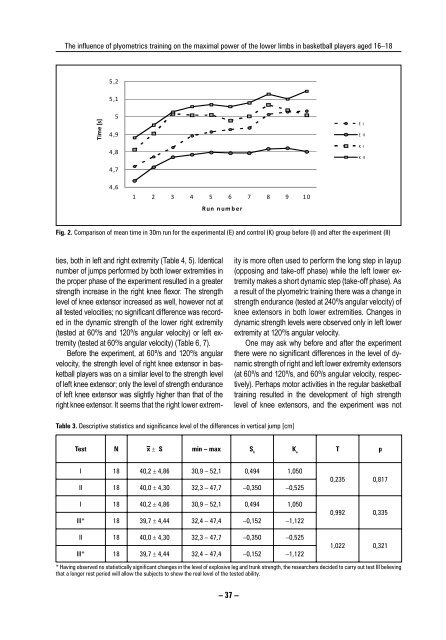full text - Akademia Wychowania Fizycznego w Krakowie
full text - Akademia Wychowania Fizycznego w Krakowie
full text - Akademia Wychowania Fizycznego w Krakowie
Create successful ePaper yourself
Turn your PDF publications into a flip-book with our unique Google optimized e-Paper software.
The influence of plyometrics training on the maximal power of the lower limbs in basketball players aged 16–18<br />
Time�[s]<br />
5,2<br />
5,1<br />
5<br />
4,9<br />
4,8<br />
4,7<br />
4,6<br />
1 2 3 4 5 6 7 8 9 10<br />
Run�number<br />
Fig. 2. Comparison of mean time in 30m run for the experimental (E) and control (K) group before (I) and after the experiment (II)<br />
ties, both in left and right extremity (Table 4, 5). Identical<br />
number of jumps performed by both lower extremities in<br />
the proper phase of the experiment resulted in a greater<br />
strength increase in the right knee fl exor. The strength<br />
level of knee extensor increased as well, however not at<br />
all tested velocities; no signifi cant difference was recorded<br />
in the dynamic strength of the lower right extremity<br />
(tested at 60º/s and 120º/s angular velocity) or left extremity<br />
(tested at 60º/s angular velocity) (Table 6, 7).<br />
Before the experiment, at 60º/s and 120º/s angular<br />
velocity, the strength level of right knee extensor in basketball<br />
players was on a similar level to the strength level<br />
of left knee extensor; only the level of strength endurance<br />
of left knee extensor was slightly higher than that of the<br />
right knee extensor. It seems that the right lower extrem-<br />
Table 3. Descriptive statistics and significance level of the differences in vertical jump [cm]<br />
– 37 –<br />
ity is more often used to perform the long step in layup<br />
(opposing and take-off phase) while the left lower extremity<br />
makes a short dynamic step (take-off phase). As<br />
a result of the plyometric training there was a change in<br />
strength endurance (tested at 240º/s angular velocity) of<br />
knee extensors in both lower extremities. Changes in<br />
dynamic strength levels were observed only in left lower<br />
extremity at 120º/s angular velocity.<br />
One may ask why before and after the experiment<br />
there were no signifi cant differences in the level of dynamic<br />
strength of right and left lower extremity extensors<br />
(at 60º/s and 120º/s, and 60º/s angular velocity, respectively).<br />
Perhaps motor activities in the regular basketball<br />
training resulted in the development of high strength<br />
level of knee extensors, and the experiment was not<br />
Test N x ± S min – max S k K u T p<br />
I 18 40,2 ± 4,86 30,9 – 52,1 0,494 1,050<br />
II 18 40,0 ± 4,30 32,3 – 47,7 –0,350 –0,525<br />
I 18 40,2 ± 4,86 30,9 – 52,1 0,494 1,050<br />
III* 18 39,7 ± 4,44 32,4 – 47,4 –0,152 –1,122<br />
II 18 40,0 ± 4,30 32,3 – 47,7 –0,350 –0,525<br />
III* 18 39,7 ± 4,44 32,4 – 47,4 –0,152 –1,122<br />
E �I<br />
E �II<br />
K�I<br />
K�II<br />
0,235 0,817<br />
0,992 0,335<br />
1,022 0,321<br />
* Having observed no statistically significant changes in the level of explosive leg and trunk strength, the researchers decided to carry out test III believing<br />
that a longer rest period will allow the subjects to show the real level of the tested ability.





![Antropomotoryka nr 57 [2012]. - Akademia Wychowania Fizycznego ...](https://img.yumpu.com/50213388/1/182x260/antropomotoryka-nr-57-2012-akademia-wychowania-fizycznego-.jpg?quality=85)











